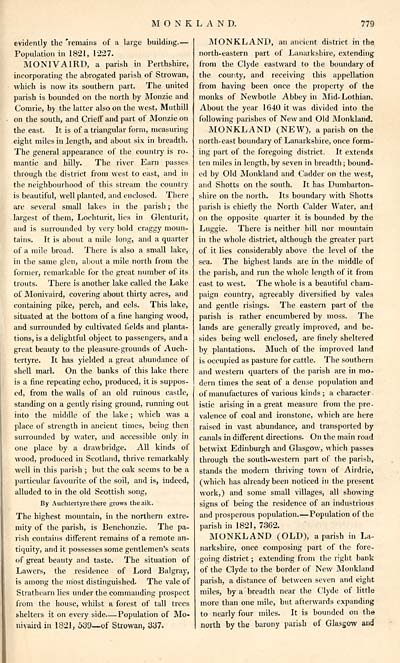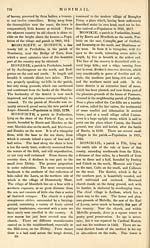Gazetteer of Scotland > Volume 2
(295) Page 779
Download files
Complete book:
Individual page:
Thumbnail gallery: Grid view | List view

M O N K L A N D.
779
evidently the 'remains of a large building. —
Population in 1821, 1227.
MONIVAIRD, a parish in Perthshire,
incorporating the abrogated parish of Strowan,
which is now its southern part. The united
parish is bounded on the north by Monzie and
Connie, by the latter also on the west, Muthill
on the south, and Crieff and part of Monzie on
the east. It is of a triangular form, measuring
eight miles in length, and about six in breadth.
The general appearance of the country is ro-
mantic and hilly. The river Earn passes
through the district from west to east, and in
the neighbourhood of this stream the country
is beautiful, well planted, and enclosed. There
are several small lakes in the parish ; the
largest of them, Lochturit, lies in Glenturit,
and is surrounded by very bold craggy moun-
tains. It is about a mile long, and a quarter
of a mile broad. There is also a small lake,
in the same glen, about a mile north from the
former, remarkable for the great number of its
trouts. There is another lake called the Lake
of Monivaird, covering about thirty acres, and
containing pike, perch, and eels. This lake,
situated at the bottom of a fine hanging wood,
and surrounded by cultivated fields and planta-
tions, is a delightful object to passengers, and a
great beauty to the pleasure-grounds of Auch-
tertyre. It has yielded a great abundance of
shell marl. On the banks of this lake there
is a fine repeating echo, produced, it is suppos-
ed, from the walls of an old ruinous castle,
standing on a gently rising ground, running out
into the middle of the lake ; which was a
place of strength in ancient times, being then
surrounded by water, and accessible only in
one place by a drawbridge. All kinds of
wood, produced in Scotland, thrive remarkably
well in this parish ; but the oak seems to be a
particular favourite of the soil, and is, indeed,
alluded to in the old Scottish song,
By Auchtertyre there grows theaik.
The highest mountain, in the northern extre-
mity of the parish, is Benchonzie. The pa-
rish contains different remains of a remote an-
tiquity, and it possesses some gentlemen's seats
of great beauty and taste. The situation of
Lawers, the residence of Lord Balgray,
is among the most distinguished. The vale of
Strathearn lies under the commanding prospect
from the house, whilst a forest of tall trees
shelters it on every side — Population of Mo-
nivaird in 1821, 539 — of Strowan, 337.
MONKLAND, an ancient district in the
north-eastern part of Lanarkshire, extending
from the Clyde eastward to the boundary of
the county, and receiving this appellation
from having been once the property of the
monks of Newbotle Abbey in Mid-Lothian.
About the year 1640 it was divided into the
following parishes of New and Old Monklarid.
MONKLAND (NEW), a parish on the
north-east boundary of Lanarkshire, once form-
ing part of the foregoing district. It extends
ten miles in length, by seven in breadth ; bound-
ed by Old Monkland and Cadder on the west,
and Shotts on the south. It has Dumbarton-
shire on the north. Its boundary with Shotts
parish is chiefly the North Calder Water, and
on the opposite quarter it is bounded by the
Luggie. There is neither hill nor mountain
in the whole district, although the greater part
of it lies considerably above the level of the
sea. The highest lands are in the middle of
the parish, and run the whole length of it from
east to west. The whole is a beautiful cham-
paign country, agreeably diversified by vales
and gentle risings. The eastern part of the
parish is rather encumbered by moss. The
lands are generally greatly improved, and be-
sides being well enclosed, are finely sheltered
by plantations. Much of the improved land
is occupied as pasture for cattle. The southern
and western quarters of the parish are in mo-
dern times the seat of a dense population and
of manufactures of various kinds; a character-
istic arising in a great measure from the pre-
valence of coal and ironstone, which are here
raised in vast abundance, and transported by
canals in different directions. On the main road
betwixt Edinburgh and Glasgow, which passes
through the south-western part of the parish,
stands the modern thriving town of Airdrie,
(which has already been noticed in the present
work,) and some small villages, all showing
signs of being the residence of an industrious
and prosperous population. — Population of the
parish in 1821, 7362.
MONKLAND (OLD), a parish in La-
narkshire, once composing part of the fore-
going district ; extending from the right bank
of the Clyde to the border of New Monkland
parish, a distance of between seven and eight
miles, by a breadth near the Clyde of little
more than one mile, but afterwards expanding
to nearly four miles. It is bounded on the
north by the barony parish of Glasgow and
779
evidently the 'remains of a large building. —
Population in 1821, 1227.
MONIVAIRD, a parish in Perthshire,
incorporating the abrogated parish of Strowan,
which is now its southern part. The united
parish is bounded on the north by Monzie and
Connie, by the latter also on the west, Muthill
on the south, and Crieff and part of Monzie on
the east. It is of a triangular form, measuring
eight miles in length, and about six in breadth.
The general appearance of the country is ro-
mantic and hilly. The river Earn passes
through the district from west to east, and in
the neighbourhood of this stream the country
is beautiful, well planted, and enclosed. There
are several small lakes in the parish ; the
largest of them, Lochturit, lies in Glenturit,
and is surrounded by very bold craggy moun-
tains. It is about a mile long, and a quarter
of a mile broad. There is also a small lake,
in the same glen, about a mile north from the
former, remarkable for the great number of its
trouts. There is another lake called the Lake
of Monivaird, covering about thirty acres, and
containing pike, perch, and eels. This lake,
situated at the bottom of a fine hanging wood,
and surrounded by cultivated fields and planta-
tions, is a delightful object to passengers, and a
great beauty to the pleasure-grounds of Auch-
tertyre. It has yielded a great abundance of
shell marl. On the banks of this lake there
is a fine repeating echo, produced, it is suppos-
ed, from the walls of an old ruinous castle,
standing on a gently rising ground, running out
into the middle of the lake ; which was a
place of strength in ancient times, being then
surrounded by water, and accessible only in
one place by a drawbridge. All kinds of
wood, produced in Scotland, thrive remarkably
well in this parish ; but the oak seems to be a
particular favourite of the soil, and is, indeed,
alluded to in the old Scottish song,
By Auchtertyre there grows theaik.
The highest mountain, in the northern extre-
mity of the parish, is Benchonzie. The pa-
rish contains different remains of a remote an-
tiquity, and it possesses some gentlemen's seats
of great beauty and taste. The situation of
Lawers, the residence of Lord Balgray,
is among the most distinguished. The vale of
Strathearn lies under the commanding prospect
from the house, whilst a forest of tall trees
shelters it on every side — Population of Mo-
nivaird in 1821, 539 — of Strowan, 337.
MONKLAND, an ancient district in the
north-eastern part of Lanarkshire, extending
from the Clyde eastward to the boundary of
the county, and receiving this appellation
from having been once the property of the
monks of Newbotle Abbey in Mid-Lothian.
About the year 1640 it was divided into the
following parishes of New and Old Monklarid.
MONKLAND (NEW), a parish on the
north-east boundary of Lanarkshire, once form-
ing part of the foregoing district. It extends
ten miles in length, by seven in breadth ; bound-
ed by Old Monkland and Cadder on the west,
and Shotts on the south. It has Dumbarton-
shire on the north. Its boundary with Shotts
parish is chiefly the North Calder Water, and
on the opposite quarter it is bounded by the
Luggie. There is neither hill nor mountain
in the whole district, although the greater part
of it lies considerably above the level of the
sea. The highest lands are in the middle of
the parish, and run the whole length of it from
east to west. The whole is a beautiful cham-
paign country, agreeably diversified by vales
and gentle risings. The eastern part of the
parish is rather encumbered by moss. The
lands are generally greatly improved, and be-
sides being well enclosed, are finely sheltered
by plantations. Much of the improved land
is occupied as pasture for cattle. The southern
and western quarters of the parish are in mo-
dern times the seat of a dense population and
of manufactures of various kinds; a character-
istic arising in a great measure from the pre-
valence of coal and ironstone, which are here
raised in vast abundance, and transported by
canals in different directions. On the main road
betwixt Edinburgh and Glasgow, which passes
through the south-western part of the parish,
stands the modern thriving town of Airdrie,
(which has already been noticed in the present
work,) and some small villages, all showing
signs of being the residence of an industrious
and prosperous population. — Population of the
parish in 1821, 7362.
MONKLAND (OLD), a parish in La-
narkshire, once composing part of the fore-
going district ; extending from the right bank
of the Clyde to the border of New Monkland
parish, a distance of between seven and eight
miles, by a breadth near the Clyde of little
more than one mile, but afterwards expanding
to nearly four miles. It is bounded on the
north by the barony parish of Glasgow and
Set display mode to: Large image | Transcription
Images and transcriptions on this page, including medium image downloads, may be used under the Creative Commons Attribution 4.0 International Licence unless otherwise stated. ![]()
| Gazetteers of Scotland, 1803-1901 > Gazetteer of Scotland > Volume 2 > (295) Page 779 |
|---|
| Permanent URL | https://digital.nls.uk/97434362 |
|---|
| Description | Volume II: Glenbanchor to Zetland. |
|---|---|
| Attribution and copyright: |
|
| Description | By Robert Chambers and William Chambers. Glasgow: Blackie & Son, 1838. 2 volumes. |
|---|---|
| Shelfmark | NF.1461.g.7 |
| Additional NLS resources: | |

